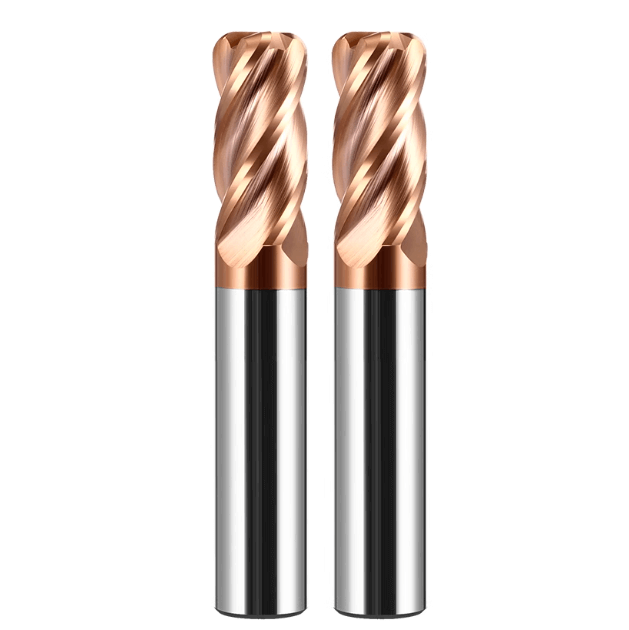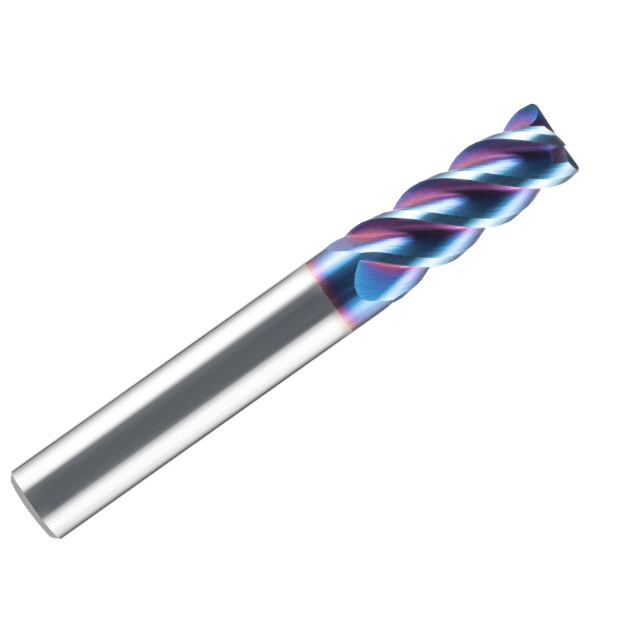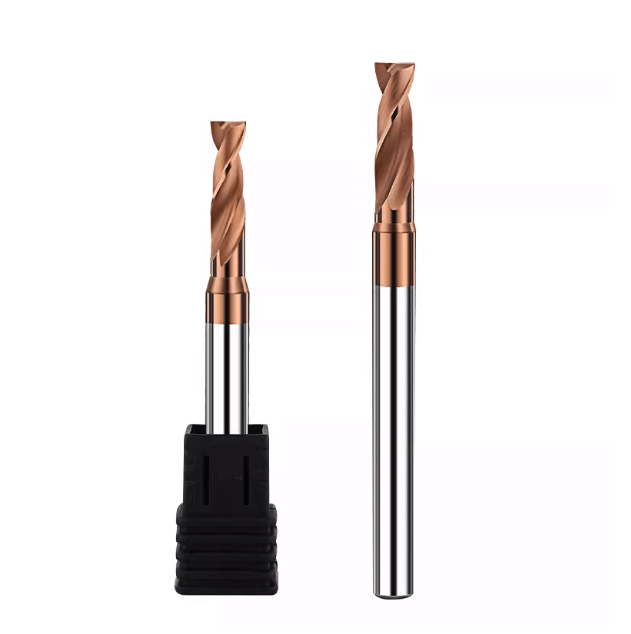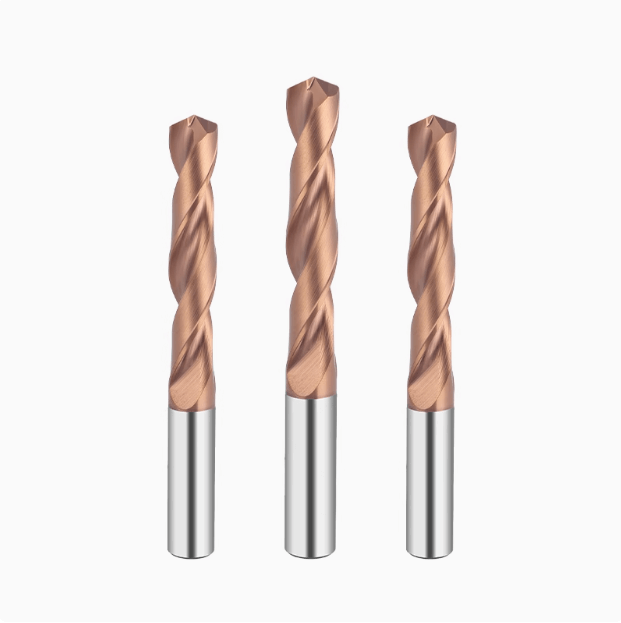Mini end mills are essential tools in precision machining, widely used for micromachining, mold making, and high-speed cutting. Their small diameter and sharp cutting edges enable flexible, precise cutting, but also make them susceptible to breakage and accelerated wear. For CNC engineers, selecting the right mini end mill, optimizing machining parameters, and implementing effective tool maintenance are key to maintaining machining efficiency and extending tool life.
Carbide mini end mills excel in machining hard materials due to their high hardness and wear resistance, but they require careful attention to feed rates, cutting depth, and tool clamping. Small end mills for micro machining are ideal for machining microstructures, producing small holes, and cutting complex 3D contours. Mini end mills for mold making demand a balance between wear resistance and surface finish. CNC micro end mills for high-speed cutting maintain stability at high speeds, yet the risk of tool breakage still necessitates scientific parameter settings and standardized operation.
By properly selecting tool specifications, optimizing tool paths, controlling cutting parameters, and implementing standardized maintenance, the risk of mini end mill breakage can be significantly reduced while improving machining efficiency and surface quality. This article systematically explores best practices for preventing mini end mill breakage, offering engineers professional guidance and helping companies make informed decisions when working with mini end mill suppliers.

Understanding Common Causes of Mini End Mill Breakage
Mini end mills provide irreplaceable advantages in micromachining, mold making, and high-speed cutting, but their delicate structure makes them prone to breakage and short tool life. Understanding the common causes of breakage is essential for optimizing machining parameters, enhancing cutting stability, and extending tool life. Key causes include material properties, excessive cutting parameters, and vibration or chatter during machining.
Material Hardness and Workpiece Compatibility
Material hardness directly affects cutting performance and tool life. Carbide mini end mills experience low cutting forces and relatively slow wear when machining soft materials like aluminum or copper. However, machining high-hardness steels, titanium alloys, or hardened mold steels generates concentrated forces that can create microcracks and fractures at the tool tip.
Material uniformity and internal stress also influence tool performance. Composite materials or workpieces with hardened layers can induce sudden overload during cutting with a small end mill for micro machining, increasing the risk of tool breakage. To mitigate this risk, engineers should select appropriate tool diameter, tip geometry, and coating type based on material properties, while adjusting feed rates and cutting depths to ensure stable chip evacuation and consistent surface finish.
Excessive Cutting Parameters and Overload
Improper cutting parameters are a major cause of mini end mill breakage. Small-diameter tools at high spindle speeds can experience overload if feed rates or cutting depths are too high. Excessive cutting forces can cause tool deflection and localized stress, increasing breakage risk.
In micromachining, carbide mini end mills are particularly sensitive due to limited rigidity. Rapid changes in cutting forces can propagate microcracks at the tool tip. Optimizing cutting parameters, using layered cutting, and reducing depth of cut are essential strategies for prolonging tool life and maintaining machining accuracy.
Vibration and Chatter in Micro Machining
Chatter is a common problem in micro machining that can reduce surface finish and cause tool breakage. Small-diameter and relatively long cutters have limited rigidity, making them vulnerable to vibration from machine movement, unstable clamping, or improper cutting parameters.
Controlling chatter requires precise tool clamping, minimizing tool overhang, adjusting cutting parameters (such as reducing cutting speed or increasing tooth count), and employing stable tool paths. Efficient chip evacuation reduces heat buildup and cutting vibration, further decreasing the risk of tool breakage during precision mold contour machining.

Optimizing Cutting Conditions for Tool Longevity
Extending mini end mill life relies on more than tool material and geometry; machining parameters play a critical role. Optimizing feed rate, spindle speed, depth of cut, and cooling or lubrication strategies can significantly reduce breakage risk, minimize wear, and improve surface finish. Properly optimized conditions also enhance chip evacuation, reduce heat accumulation and tool deflection, and enable high-precision, efficient machining.
Feed Rate and Spindle Speed Adjustment for High-Speed Cutting
CNC micro end mills for high-speed cutting demand careful balancing of spindle speed and feed rate. Excessive feed rates generate high cutting forces, potentially causing microcracks at the tool tip. Too low feed rates increase friction, heat buildup, and reduce tool life.
Optimizing feed and speed based on material hardness, tool diameter, tooth count, and geometry ensures balanced cutting. Layered cutting or multiple shallow cuts reduce instantaneous force peaks while improving surface finish and microstructure accuracy. This is especially important when machining high-hardness mold steels or copper and aluminum alloys.
Depth of Cut and Step-over Control for Mold Making
Cutting depth and step-over critically affect mini end mill performance in mold making. Excessive cutting depth increases cutting forces, tool deflection, and breakage risk, while negatively impacting surface flatness and dimensional accuracy.
Controlling depth and step-over ensures uniform cutting force, reduces heat buildup, and improves chip evacuation. Layered cutting, contouring, or spiral strategies minimize force fluctuations, preserve tool life, and enhance surface finish and microstructure integrity.
Coolant and Lubrication Strategies
In high-speed and precision micromachining, coolant and lubrication are vital. Coolant dissipates heat, lowers tool tip temperature, and prevents thermal deformation and microcracks. For small-diameter tools, coolant improves chip evacuation and prevents clogging.
Lubrication reduces cutting friction and tool edge wear, improving surface finish. High-pressure or mist cooling (MQL) is particularly effective for mini end mills used in mold making or high-speed aluminum and copper machining, significantly extending tool life while maintaining accuracy. Selecting appropriate cooling and lubrication strategies is key for stable, efficient micro tool operation.

Selecting the Right Mini End Mill for Specific Applications
In micromachining, mold making, and high-speed cutting, each application places unique demands on the material, geometry, and coating of mini end mills. Selecting the right tool not only enhances cutting efficiency but also extends tool life, ensures superior surface finish, and minimizes tool breakage and excessive wear.
Engineers must carefully match the optimal tool type according to the workpiece material, part geometry, tool diameter, and cutting-edge shape. Incorporating the right machining parameters and proper tool maintenance strategies further ensures reliable and consistent performance. The following analysis explores tool selection from three key perspectives: material comparison, micromachining requirements, and mold-making considerations.
Carbide Mini End Mills vs. Coated Variants
Carbide mini end mills are known for their high hardness, rigidity, and wear resistance, making them ideal for machining materials such as steel, aluminum alloys, and copper. In typical micromachining or mold manufacturing tasks, solid carbide tools provide stable cutting performance and extended tool life.
Coated mini end mills, enhanced through PVD or CVD coatings, offer improved surface hardness, thermal resistance, and anti-adhesion properties. They perform exceptionally well in high-speed or high-temperature cutting conditions and when machining sticky materials. These coatings reduce friction, improve chip evacuation, and delay tool wear—key benefits when machining microstructures or complex contours. Tool selection should consider the material type, cutting speed, and life expectancy to achieve optimal performance.
Choosing Small End Mills for Micro Machining
Selecting the right small end mill for micro machining requires balancing tool diameter, number of flutes, tip geometry, and rigidity. Tools that are too small can easily deflect or chatter, while those too large may fail to reach fine features.
Other influencing factors include material hardness, surface finish requirements, and heat accumulation during cutting. For high-precision components or micro-holes, carbide or coated tools are recommended due to their superior hardness and wear resistance. When combined with layered cutting or contour toolpath strategies, these tools help distribute cutting forces evenly, ensuring dimensional accuracy and a fine surface finish.
Mini End Mills for Mold Making: Key Considerations
Mold making demands extreme precision, wear resistance, and surface quality from cutting tools. When selecting a mini end mill for mold making, engineers should evaluate tool material, coating, tip geometry, flute number, and corner radius design. Carbide tools provide excellent rigidity and durability, while coated variants are ideal for high-speed cutting and anti-sticking applications.
Factors such as tool length-to-diameter ratio, cutting depth, stepover strategy, and coolant application also directly influence tool life and surface finish. In precision cavity machining or micro-feature cutting, matching tool specifications with optimized process parameters ensures high accuracy, low breakage risk, and superior efficiency.

Best Practices for Tool Handling and Maintenance
Mini end mills used in micromachining and mold making require strict handling and maintenance to ensure long service life and consistent machining quality. Even high-performance carbide or coated cutters can suffer premature wear or breakage due to improper use. Adopting correct clamping methods, performing regular inspections, and following standardized storage and handling procedures are key to maintaining cutting stability and performance.
H3: The Impact of Precise Tool Holding and Clamping on Mini End Mill Life
Mini end mills have limited rigidity due to their small diameters and slender geometry. Any instability or misalignment in clamping can lead to tool deflection or vibration, significantly increasing breakage risk.
Proper clamping techniques include selecting the right collet, minimizing tool overhang, maintaining consistent clamping pressure, and ensuring the spindle runs concentric. For CNC micro end mills used in high-speed cutting, accurate clamping not only stabilizes the tool but also improves chip evacuation, extends tool life, and maintains surface quality.
Importance of Regular Inspection and Wear Monitoring
Routine inspection is essential for maintaining accuracy and reliability in micromachining. Tool wear, microcracks, or edge chipping can cause dimensional errors, chatter, or tool failure.
A structured monitoring system—such as periodic visual checks, microscope inspection, measuring tool tip radius, and tracking cutting force—helps detect wear early. Replacing or regrinding worn tools before failure ensures stable machining quality, particularly for small end mills used in precision mold making or micro machining operations.
Storage and Handling Tips from Mini End Mill Suppliers
Proper storage and handling significantly affect the performance of mini end mills. Mini end mill suppliers typically recommend storing tools individually in protective boxes that are shockproof, moisture-resistant, and dustproof.
When handling, use designated fixtures or tool trays to prevent contact with sharp edges. For tools stored long-term or used in high-precision applications, inspect coating integrity and edge sharpness before use. Correct handling and storage not only extend tool life but also ensure consistent performance in CNC micro end mills for high-speed cutting and mold machining applications.
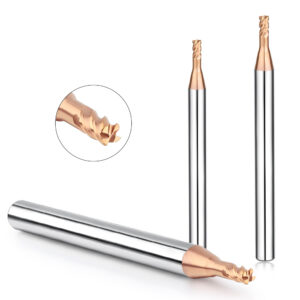
Advanced Strategies to Prevent Tool Breakage
In micro machining and mold manufacturing, the small diameter of mini end mills makes them prone to tool breakage. Beyond optimizing cutting parameters and maintenance, adopting advanced machining strategies can drastically reduce this risk while improving cutting stability, efficiency, and overall tool life. These include high-speed machining techniques, optimized toolpath planning, and custom tool design for specialized applications.
Advanced Cutting Techniques for CNC Micro End Mills in High-Speed Cutting
When using CNC micro end mills for high-speed cutting, maintaining the right balance between feed rate, cutting speed, and tool rigidity is critical. Key advanced techniques include:
-
Layered Cutting: Reduces the depth of cut per pass to minimize cutting force and vibration.
-
Adaptive Feed Rate Control: Dynamically adjusts feed rate based on tool geometry and material hardness for more stable cutting.
-
Thermal Management: Using coolant or MQL helps dissipate heat, preventing thermal cracking and extending tool life.
These strategies enhance cutting stability in both micro machining and precision mold processing.
Optimized Tool Paths for Complex 3D Surfaces
Machining complex 3D geometries demands precise toolpath planning. Well-optimized paths reduce stress on the cutting edge, improve chip evacuation, and enhance surface quality.
Common strategies include:
-
Contour Tool Paths: Follow the surface shape to evenly distribute cutting forces.
-
Spiral or Hybrid Tool Paths: Provide smoother transitions and minimize tool tip stress.
-
Adaptive Depth of Cut: Automatically adjusts engagement depth to prevent tool overload.
Such approaches extend the life of small end mills for micro machining and improve accuracy in mold and precision component production.
Custom Mini End Mills for Specialized Applications
Standard tools may not always meet the precision or durability needs of specialized applications. Custom mini end mills are designed with tailored geometries, coatings, and materials to suit specific machining requirements.
Customization options include adjusting tool diameter and length to improve rigidity, applying optimized coatings for thermal and wear resistance, and refining tip designs (e.g., micro ball, radius, or sharp tips) for intricate cavities or micro-features.
These solutions enable engineers to reduce tool breakage, enhance machining consistency, and maximize performance in demanding micromachining and mold-making applications.
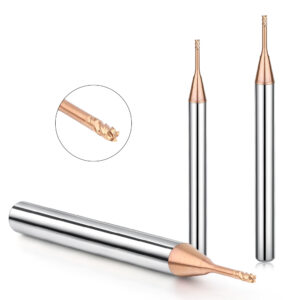
Best Practices to Avoid Mini End Mill Breakage in CNC Micro Machining and Mold Applications
Mini end mills play an essential role in micromachining, mold making, and high-speed cutting. However, due to their small diameters and delicate tips, they are inherently prone to breakage. The strategies summarized below integrate key principles from tool selection, cutting optimization, and maintenance practices to help engineers achieve stable and efficient machining results.
First, selecting the right tool type and material is fundamental. Carbide mini end mills offer outstanding rigidity and wear resistance, making them ideal for most micromachining and mold-making operations. Coated mini end mills, enhanced by PVD or CVD technology, provide superior performance in high-speed cutting or when machining sticky materials. They reduce friction, improve chip evacuation, and deliver a smoother surface finish. For micromachining tasks, parameters such as diameter, number of flutes, and tool tip geometry must be carefully matched with the workpiece material, cutting depth, and precision requirements. In mold-making applications, tool design should balance wear resistance, cutting stability, and surface quality.
Secondly, optimizing machining parameters and cutting strategies is crucial to minimizing tool stress and breakage. Fine-tuning the feed rate, spindle speed, depth of cut, and step-over can significantly improve cutting stability. Combining these adjustments with layered cutting, contour, or spiral toolpath strategies helps reduce tool deflection, chatter, and thermal buildup while maintaining high cutting efficiency and precision. Additionally, proper coolant and lubrication management—especially for CNC micro end mills used in high-speed cutting—can further reduce friction, extend tool life, and stabilize machining performance.
Proper tool handling and maintenance are equally vital. Precise clamping minimizes tool runout and vibration, while regular wear inspections and timely tool replacement prevent sudden failure. Following storage and handling guidelines recommended by mini end mill suppliers helps protect delicate cutting edges from damage. For demanding applications, custom mini end mills can be tailored for specific materials, tool geometries, and cutting requirements, offering enhanced performance and lower breakage risk.
In summary, minimizing the risk of tool breakage in CNC micro machining and mold-making requires a systematic approach: select the right carbide or coated mini end mill, optimize cutting parameters, implement proper handling and maintenance routines, and utilize customized tools when necessary. These practices not only improve machining accuracy and surface finish but also significantly extend tool life. Partnering with experienced mini end mill suppliers ensures access to expert recommendations, technical support, and tailored tool solutions—providing a reliable foundation for high-efficiency and precision machining.




